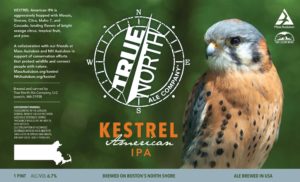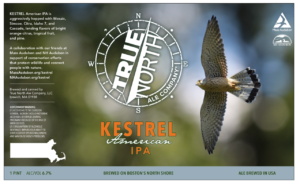We’ve teamed up with True North Ale Company to help bring their exceptional Kestrel American IPA into New Hampshire! Mass Audubon partnered with the brewery last spring to launch the specialty ale in Massachusetts, and this spring NH Audubon joins the effort and rewards of sharing the tasty brew across the border. A portion of the sales of Kestrel IPA will be donated to NH Audubon in support of bird conservation.
**In June, this specialty ale won a Gold Medal at the North American Brewers Association International Competition**

A collaboration with our friends at Mass Audubon and NH Audubon in support of conservation efforts that protect wildlife and connect people with nature.”
Join us at Fody’s Tavern in Derry on Saturday, June 18, 2022 from 1-3pm: Kestrel IPA will be on draft and we’ll be there with our resident Red-tailed Hawk. Stop by, enjoy a meal and a pint, and learn more about our native raptors!
Where to find Kestrel IPA in NH (pdf)
How are Kestrels doing in NH?
Take a look at their status in our recent State of the Birds report:
Current Trends: Birds of prey have generally been the beneficiaries of focused conservation actions. The banning of DDT in the 1970s, and targeted efforts such as captive breeding, allowed for recovery of Osprey, Bald Eagle, and Peregrine Falcon across the eastern United States. Smaller raptors such as the Cooper’s Hawk also probably increased at least in part thanks to efforts initiated for other species, but not so the American Kestrel. Kestrels have been declining in New Hampshire and the Northeast at between 2 and 4% per year, which means there are less than a third as many of these small falcons as there were 50 years ago. Declines seem to be larger in the south than in the north, and kestrels are a much more reliable sight north of the White Mountains.
Primary Threats: Reasons for the kestrel decline are not well-understood. Intensified agriculture, which entails monocultures and heavy pesticide inputs, could be impacting the insects that make up a significant portion of the birds’ diet. This same threat has been proposed for other open country birds like many of our swallows. Loss of farmland and resulting regrowth of forests eliminates the open habitats kestrels need to forage. There is even speculation that increasing populations of Cooper’s Hawks might be preying on kestrels, especially young and inexperienced birds that have just left the nest.
Conservation Actions: More research is needed to understand the effects of pesticides on kestrel populations. In the meantime, efforts to help kestrels by erecting nesting boxes are expanding in New England. For more information, visit the American Kestrel Partneship.

